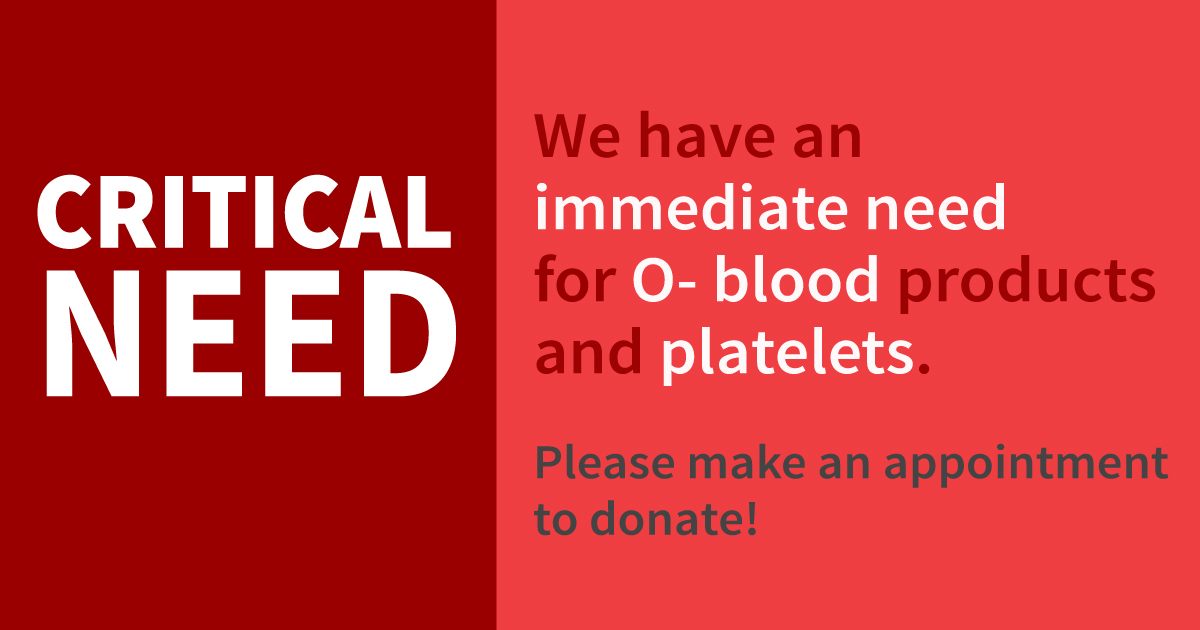
Behind a Critical Need for Blood Products at Stanford Blood Center
You may have seen messaging earlier this month letting you know that Stanford Blood Center (SBC) was in critical need of O-negative blood products and platelets. If you are an O- blood donor or a platelet donor, you may have even received a phone call or email asking you to come in and donate. Or if you have a different blood type and saw our message on our website or social media, perhaps you’re thinking, “Don’t they always need blood? Why is now different?”
The truth is, we do always need all blood types and each week we must collect a certain number of units of each type of blood product to meet the anticipated demand of our hospital partners. That being said, some blood types are used frequently but are found less commonly than others – check out this chart to see how rare your type is – and this means there are fewer people donating those products making it more challenging to keep our supply at optimal levels.
When SBC is experiencing difficulty filling appointments of a particular blood type and do not have the optimal amount on the shelves to meet anticipated demand, we consider ourselves in a critical need situation. Let us break it down for you. Here is what it means when we are in a critical need situation.
Why Does the Blood Supply Decrease?
During certain times of the year, blood centers across the country predict shortages of blood products. Generally, these times occur in the summer months of July through September, and the winter months of December through February. The primary reasons for shortages during these times are vacation travel, high schools and colleges being out of session (student donors make up a significant percentage of our donor base), and in the winter, cold and flu.
This January, we’ve seen a particularly bad cold and flu season in the Bay Area and unless healthy donors come in to help us boost the blood supply, we could potentially not have the products needed to support local patients. While we have a wonderful group of donors who are willing to step up and fill appointment slots, many of those donors can come down with an illness and need to cancel. As a result, one appointment slot sometimes needs to be refilled 2 or 3 times before we are able to actually get a donor in the door to collect a unit of blood. Add to that the short shelf life of platelet products (5 days), and you can see why the need to constantly collect is so important.
So How Does SBC Determine a Critical Need?
SBC has dedicated staff from various departments across the organization that are continually communicating and evaluating the inventory of blood products on the shelves, monitoring the number of appointments scheduled in centers and at mobile blood drives, and the scheduled procedures at the hospitals that we supply. This requires coordination from SBC’s Donor Recruitment team, Collections team, Technical Services, which includes testing and manufacturing and inventory management, Marketing and Communications, and the Medical Director who is in constant communication with transfusion services at the hospitals, to name a few. If the amount and type of blood products on hand are not anticipated to meet the needs of the procedures scheduled, plus a buffer to account for potential emergencies, then it is determined that a critical call for products needs to occur.
The Process of Critical Messaging
Once the determination is made that we have a critical need, the Marketing and Communications department works with the other departments on creating a communications plan to help boost donation appointments. The first step generally starts with contacting existing eligible donors by phone and putting messaging out on our social media channels. The next step, if the need persists, is to send targeted emails to existing donors. Next, the website will be updated with a banner containing critical messaging. Finally, we will send out a press release to ask for help from the media in spreading the word.
In most cases, due to the amazing support from our community, we are able to fill enough appointments and collect enough products to revive the blood supply. If the shortage persists or is being experienced elsewhere, we may also partner with nearby blood centers on our messaging.
Each time we need to put out critical messaging, serious consideration is put into the decision. Donors’ time is valuable, so we reserve this call to action for when it is really needed. The goal is to send the right messaging to the right donors at the right time to help patients in need.
We hope this helps our donors and potential donors understand why we sometimes urgently request that people with certain blood types make an appointment. Thank you to all of the donors who have answered this call in the past. It truly does impact patients in your community. If you would like to make an appointment to donate blood, please visit https://stanfordbloodcenter.org/.
